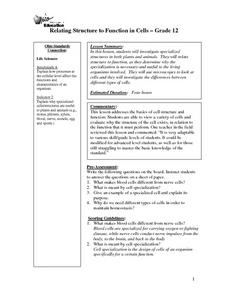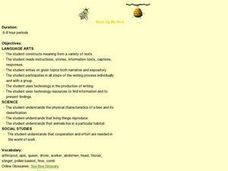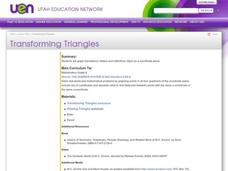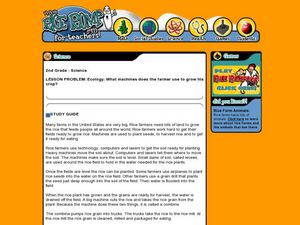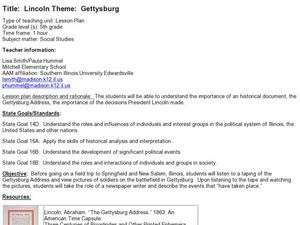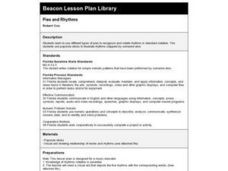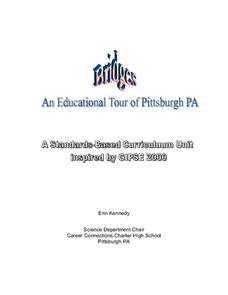Curated OER
The Stroop Effect
Students explore the specific areas of the brain that process different types of information. They examine processing conflicts. Students participate in a hands-on minds-on activity using the Stroop Effect. They design psychological...
Curated OER
Fingerprinting
For this fingerprinting worksheet, learners write short answers to 16 questions about the principles of fingerprinting. They explain how this method is used to identify criminals.
Curated OER
Analyze This
Students gain practice in the analysis of various types of graphs common in daily life. These examples often use graphic images like charts, graphs, tables, and pictures to supplement learning.
Curated OER
Relating Structure to Function in Cells
Twelfth graders investigate specialized structures in both plants and animals. They relate structure to function, as they determine why the specialization is necessary and useful to the living organisms involved. They use microscopes...
Curated OER
Water Filtration
In this water pollution and filtration lesson plan, 5th graders read the story 'Saving Salila's Turtle' and discuss the impact pollution has had on the Ganges river. Students work in groups to brainstorm different types of water...
Curated OER
Colorful Fractions
Students use charts to show fractions. In this fractions and percents lesson, students review fractions, percents and ratios. Students create tables and color the cells to make different fractions. Students answer...
Curated OER
Parts of a Tree
Young scholars identify four parts of trees. In this plant biology instructional activity, students read the book Trees and conduct Internet research to identify the parts of the tree. Young scholars take notes from each website and...
Curated OER
Mammals: Teeth and Diet
In this mammals' teeth and diet worksheet, students read for information, identify kinds of teeth, and sort animals into categories. In this fill in the blank and T-Chart worksheet, students write multiple answers for two questions.
Curated OER
Digital Dreams
Students write a speech. In this dreams lesson, students define the word dreams and list their own dreams. Students read and discuss Langston Hughes work, read and discuss excerpts from speeches by JFK and Martin Luther King,...
Curated OER
Analyze The Learner; Chocolate Fractions
Third graders describe, represent and compare fractions using pieces of a chocolate bar. In this fractions lesson, 3rd graders demonstrate how to read and write fractions correctly. Students then integrate technology by using...
Curated OER
Buzz Up My Hive
Students research bees. In this organisms instructional activity, students participate in various learning centers to find out more about bees. The centers include watching a video and taking notes, reading books about bees, and going on...
Curated OER
Transforming Triangles
Sixth graders graph translations (slides) and reflections (flips) on a coordinate plane. They visualize and identify geometric shapes after applying transformations on a coordinate plane. Finally, 6th graders write a paragraph telling...
Curated OER
Brass Instruments
In this music instructional activity, students read about the 4 main brass instruments in the orchestra: trumpet, horn, trombone, and tuba. Students also write the missing words into 8 sentences.
Curated OER
What Time Is It?
In this clocks learning exercise, students first read a one page text about different kinds of clocks. Using a word bank, students label the parts of four different kinds of clocks: grandfather, wristwatch, digital and analog. Students...
Curated OER
Review of Life Cycle
Students illustrate the life cycle of a butterfly. In this life cycle lesson, students use the book From Caterpillar to Butterfly and the Internet to learn about life cycles. Students use different types of pasta to represent the...
Curated OER
Machines Rice Farmers Use
Second graders investigate rice farming. In this farming equipment lesson, 2nd graders discover what type of equipment is needed to get rice farms ready to plant. Students gain knowledge about what a combine does and how it is important...
Curated OER
Lincoln Theme--Gettysburg
Fifth graders explore the significance of the Gettysburg Address. In this United States history lesson plan, 5th graders listen to a Gettysburg Address recording and look at photos of the battlefield. Students discuss their observations...
Curated OER
Human Fingerprints: No Two the Same
Sixth graders explore scientific observations by analyzing a group of data. In this fingerprint identification lesson, 6th graders identify the reasoning behind fingerprinting and create their own ink fingerprints. Students discuss the...
Curated OER
Characterization
In this story elements worksheet, students complete a graphic organizer about characterization. Students describe the character's words, personality, appearance and reputation. There are four bubbles within the graphic organizer to...
Curated OER
Dealing with Differences
Students list at least ten things they have a hard time doing. After reading and discussing Be Good to Eddie Lee, Students, in cooperative groups, write at least six ways people can assist people with disabilities.
Curated OER
Pies and Rhythms
Second graders, using popsicle sticks. illustrate rhythms clapped by someone else. They use different types of pies to recognize and notate rhythms in standard notation.
Curated OER
A Clone of Your Own: The Legal Issues and the Future of Genetic Engineering on Humans
Twelfth graders define cloning in their own words and examine the different types of cloning. After reading an article, they summarize it in their own words and use the internet to research the history of cloning. In groups, they...
Curated OER
Bridges
Students are introduced to the different types, designs and nature of bridges. They observe a historical look at the bridges in and around the Pittsburgh area through a video presentation. Connections are made between science and...
Curated OER
Ideal Gas Law
In this gas law activity, students review the Idea Gas Law equation and practice applying the equation to chemical reactions. Students write the balanced reaction, determine the limiting reagent, moles produced, and volume of gas...



